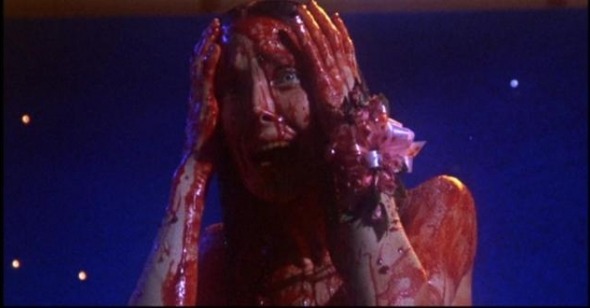Female Trouble
Jeannette Catsoulis on Carrie
Carrie turns 30 this year, and if you were to see the film today for the first time I can’t imagine how you would respond. Back in 1976, audiences were more tender and less jaded, more easily tricked and less ideologically judgmental (I wasn’t in this country then, but I don’t recall Christians being particularly exercised over the film’s blasphemous iconography). Today’s moviegoers, however, are steeped in digital blood and shocked into stupefaction by the time they reach their preteens; heads filled with horrific images unrealizable 30 years ago, virgin viewers would experience Carrie from this side of a tunnel of knock-offs—both of the film and of its director—and may find their only interest lies in seeing a pre-Fever Travolta being gobsmacked by Nancy Allen. I suppose there are worse reasons to love a movie.
As one of those original viewers, I sidled in to Carrie (only boys were supposed to like horror) knowing little of Stephen King and even less of Brian De Palma, my fledgling appetite for terror tweaked by the extravagances of The Exorcist. I remember thinking that the trailer made Sissy Spacek look a little like an albino Linda Blair, and since I wasn’t yet capable of critiquing the genre’s insatiable appetite for the destruction of hot young women (gender politics in film had yet to rear its theoretical head, at least in my working-class, Glasgow neighborhood), I saw nothing offensive and everything transgressive in the film’s feet-first dive into the terrors of female puberty. Menstruation had never been this cinematic, this visible, or this transformative.
That it was a man who achieved this was both amazing and weirdly necessary; and I don’t think De Palma has ever been given enough credit for dragging the patriarchal dread of female sexuality into the light of popular culture. While Carpenter and Craven, et al, were unanimously paving the way for a legion of genre movies that aspired to the visual equivalent of a chastity belt—keep your legs closed, honey, or the monster will get you—De Palma was presenting the curse as a blessing, an escape from awkwardness and a path to strength and independence and love. In Carrie, it’s the people who mock or otherwise seek to block this transformation—who ruin Carrie’s dream date with the angelic Tommy Ross (William Katt)—who are responsible for perverting it, and who die for their trouble: Piper Laurie’s religious fanatic of a mother who wants her daughter to remain an infant, and the female classmates whose metaphorical stoning in the shower only highlights their own self-disgust. Carrie, the virgin (probably the only one on screen), is purity run amok. Her last name is White for a reason.
The alignment of menstrual blood and supernatural power is of course an ancient trope, popping up everywhere from African tribal lore to goddess worship, from Western literature to the murderous Danaids of Greek mythology. (When not withering crops, menstruating women can usually be found tainting food and infecting livestock.) Almost every religion, being male-dominated, is squeamish about it, and it’s not inconceivable that Carrie could be read by some believers as an extreme warning of the dangers of an unchecked and newly-minted female libido. But Carrie’s final, triumphant rampage occurs not because of her sexual readiness but because of other people’s regressive reactions to it. If Carrie is a warning of anything, it’s of the dangers of religious programming (though I doubt it’s a warning any sane person today really requires).
Not that De Palma had anything quite that highfalutin in mind when he designed this gasping, gothic extravaganza. A master of basic-instinct filmmaking who admits he has always been a voyeur, De Palma is never happier than when shoving our faces—and, by extension, his own—into female crotches. Both Carrie and Dressed to Kill open with Psycho-inspired shower scenes, the latter offering extended viewing of Angie Dickinson’s pubic area (or at least her body double’s). Both scenes start slowly and hazily, with the camera creeping closer to the woman’s body and the string-filled score swooning romantically; both turn ugly and terrifying with the abruptness of a dream crashing into a nightmare.
Dickinson’s character in Dressed to Kill, Kate Miller, is what a non-telekinetic Carrie might have become: a lonely housewife destroyed by the allure of cheap thrills. In both films, the increasingly menacing mood of a pivotal scene—Carrie and Tommy dancing at the prom, Kate and a stranger circling each other in a museum—is conveyed solely by De Palma’s swooping, vertiginous camera. His shots begin wide and stealthily close in; his style is creamy, seductive, and predatory. He has the eye of a stalker.
In Carrie, the female body drives the narrative, and we are constantly reminded of the consequences of its violation. (Even in the pious White household, a semi-draped dress form lurks accusingly in the background.) The climax is a girlpower caricature of Russ Meyer proportions, a horror movie Robert Crumb might have written and would certainly get off on. Its male characters (as in all of Crumb’s work and most of De Palma’s) are weak, effeminate and ineffectual (even stud Travolta gets that whack on the jaw), its women either harpies or misguided, ambivalent do-gooders. As with Crumb, De Palma’s comedy erupts from the intersection of lust and punishment.
Wickedly reckless and deliriously tasteless, Carrie is about the creation of a sorceress, a geek-girl fantasy—what nerdy high-school chick hasn’t longed to zap the popular bitches?—rife with hilarious sexual symbolism (my personal favorite is Carrie’s control of a wildly leaping fire hose). No movie ever needed to end with an orgasm as much as this one, and De Palma rises to the occasion with a scene many have imitated but none have duplicated. Even when his heroine is postmortem, it seems De Palma can’t stop watching.
